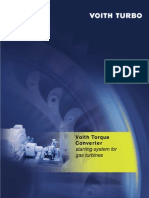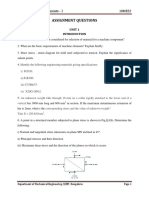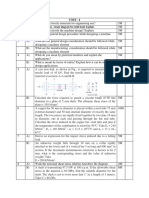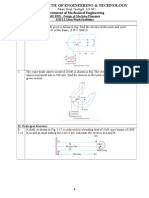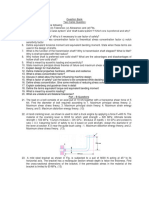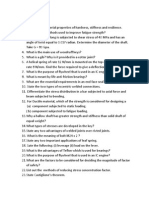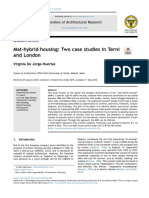Assignment 1
Assignment 1
Uploaded by
Anand DevCopyright:
Available Formats
Assignment 1
Assignment 1
Uploaded by
Anand DevOriginal Description:
Copyright
Available Formats
Share this document
Did you find this document useful?
Is this content inappropriate?
Copyright:
Available Formats
Assignment 1
Assignment 1
Uploaded by
Anand DevCopyright:
Available Formats
DEPARTMENT OF MECHANICAL ENGINEERING
S7 ME MACHINE DESIGN I Assignment No.1 To be submitted on 22-09-2014
1. A cylindrical bar of Cast Iron is subjected to a twisting moment of 4.5 kNm and a bending
moment of 3.5 kNm. Determine the minimum diameter of the bar based on a factor of safety of
2.25 if the loading is static.
2. A spherical shell 2.5 m diameter and 4 mm thick, is subjected to an internal pressure p. Suggest
the maximum value of the internal pressure, if the failure of the shell is to be prevented according
to the following theories of elastic failure:
(a) Maximum shear stress theory
(b) Maximum distortion energy theory
The yield point of the material of the shell in simple tension is 280 MPa and the Poissons ratio is
0.3. Assume the factor of safety to be 4.
3. A machine frame is made of steel with a yield point of 350 MPa in tension and 190 MPa in shear.
When loaded in a test fixture, the stresses were found to vary linearly with load. Two points on
the surface were found to be most critical. With a 6 kN test load, the stresses at these points were:
(a) Point A - 1 = 240 MPa ; 2 = 100 MPa
(b) Point B - 1 = 180 MPa ; 2 = 110 MPa
Compute the test load at which the frame will experience initial yielding according to:
(i) Maximum normal stress theory
(ii) Maximum shear stress theory
(iii) Maximum distortion energy theory
Discuss briefly the relative validity of each theory for this application. Considering all the
information available, what is your best judgment of the value of test load at which yielding would
actually be expected to begin?
4. A round steel rod is subjected to axial tensile stress of 70 MPa with a superimposed shear stress of
60 MPa due to torsion. What is your best estimate of the safety factor with respect to initial
yielding if the material has its tensile yield strength of 450 MPa.
5. A hollow shaft 8 m long made of cold rolled steel is used to transmit a static torque of 700 Nm.
The shaft is simply supported at its ends on bearings. The ratio of inner to outer diameter of the
shaft is 0.75. The shaft experiences bending owing to its own weight also. Determine the
required shaft diameter using different theories of failure. Use a factor of safety of 3 and a yield
stress of 280 MPa.
6. A triaxial state of stress is given by the tensor shown below. If the material is cold drawn steel
with yield stress of 380 MPa and the required factor of safety is 3.0, check whether the design is
safe or not, by the maximum distortion energy theory of failure.
105 40 25
40 80 30
25 30 70
ij
MPa
7. A static force F is applied at D near the end of the 375 mm lever shown in figure1. Using Von-
Mises theory of failure, determine the maximum force F that can be applied if the critical section
is at A. Yield strength of the material is 340 MPa. Use a factor of safety of 2.2.
Figure 1 Figure 2
8. Figure2 shows a shaft mounted in bearings at A and D and having pulleys at B and C. The forces
shown acting on the pulley surfaces represent the belt tensions (treated as static forces). The shaft
is to be made of 20 Mn 2 alloy steel, hot rolled. Using a factor of safety n of 2.8 and neglecting
stress concentration effects, determine the diameter of the shaft.
9. By modern standards, the shaft design of Problem-8 is poor because it is too long. Suppose the
shaft is redesigned by halving the lengths of each section between A and D. Using the same
material and factor of safety as in Problem-8, find the new shaft diameter.
10. A camshaft 20 mm diameter, mounted on ball bearings, carries a cam mid-way between the
bearings. Distance between the bearings is 240 mm. The follower which weights 800 N is out-of-
adjustment due to which an impact is produced when it is contacted by the cam. The height of fall
of follower is 0.5 mm. Determine the maximum stress induced in the shaft and the corresponding
deflection if the material of the camshaft is mild steel.
11. A 400 N load drops from a height of 200 mm and impacts the free end of a horizontal cantilever
beam 500 mm long. The beam has a rectangular cross section with depth to width ratio of 0.8. If
the maximum allowable bending stress is 180 MPa, find the cross section of the beam. Also
determine the maximum deflection if the Youngs modulus of elasticity is 210 GPa.
12. A mild steel connecting rod of square cross section is subjected to a completely reversed axial load
of 120 kN. Suggest a suitable size of the rod using a factor of safety of 2.4, if the suggested life of
the rod is 210
5
cycles only. Take a surface finish factor of 0.8. Choose the other factors suitably.
13. A hot rolled steel shaft 600 mm long and supported between bearings at its ends, is subjected to a
torsional load that varies from 2.8 kNm clockwise to 1.4 kNm anticlockwise and a central
concentrated load that varies from 3.5 kN to 1.8 kN. The shaft is of uniform cross section.
Determine the required shaft diameter if the material has an ultimate strength of 640 MPa and a
yield strength of 420 MPa. Assume a factor of safety of 2.2.
14. Find the value of factor of safety if the part in figure-3 is made of C-40 steel and of uniform
thickness of 40 mm.
Figure-3 Figure-4
15. A simply supported beam 40 mm diameter and 600 mm long is subjected to a central concentrated
load which varies from W to 3W. The material of the beam is cold rolled steel. Determine the
maximum value of W, if the design factor is to be 2.4. Use a size factor of 0.85 and a surface
finish factor of 0.9.
16. The general proportions of a shaft for an idler pulley with a constant overhung load are shown in
figure-4 with dimensions in mm. The material is an oil-quenched and normalized alloy steel with
ultimate tensile strength of 810 MPa and yield strength of 500 MPa. From the right, let the
diameters be 85, 100 and 120 mm. All surfaces are machined. The fillet radius at a-a is
restricted by ball bearing to 2 mm, but the fillet radius at b-b can be more generous, with perhaps
r/d = 0.075. Estimate the factors of safety at planes a-a and b-b. Assume the pulley to be keyed
to the shaft.
17. Bearing reactions R1 and R2 are exerted on the shaft shown in figure5, which rotates at 1200
r.p.m. and supports a 45 kN bending force. Use S.A.E. 1095 steel. Specify the diameter d using a
design factor of n = 1.6 for a life of 8 hours. The surfaces are machined.
Figure 5
10040 kN
60 mm
100 mm
10 mm radius
20 mm dia
You might also like
- Alarm Center Users ManualDocument210 pagesAlarm Center Users ManualW R Small100% (4)
- Machine Design Elements and AssembliesFrom EverandMachine Design Elements and AssembliesRating: 3.5 out of 5 stars3.5/5 (2)
- A245EDocument21 pagesA245EDavid Chalker94% (48)
- Stress Concentration ExamplesDocument5 pagesStress Concentration ExamplesUday Narasimha100% (2)
- Voith Hydraulic Start SystemDocument20 pagesVoith Hydraulic Start Systemvasantgk100% (1)
- Pass Task 3.1: Drawing Program - Drawing: Swinburne University of TechnologyDocument9 pagesPass Task 3.1: Drawing Program - Drawing: Swinburne University of TechnologyHiếu PhanNo ratings yet
- DMM - I Question Bank For StudentsDocument11 pagesDMM - I Question Bank For StudentsDushyanthkumar DasariNo ratings yet
- DMM - I Question Bank For StudentsDocument11 pagesDMM - I Question Bank For StudentsDushyanthkumar DasariNo ratings yet
- Dme Lab Sheets Ii Iii IvDocument4 pagesDme Lab Sheets Ii Iii IvA58Vikas UbovejaNo ratings yet
- Assignment 02Document2 pagesAssignment 02adhnan_rasheed0% (1)
- ME-6503 Design of Machine Elements - 16 MarksDocument12 pagesME-6503 Design of Machine Elements - 16 MarksMadhu MithaNo ratings yet
- Mech-V-Design of Machine Elements I (10me52) - AssignmentDocument10 pagesMech-V-Design of Machine Elements I (10me52) - AssignmentArunNo ratings yet
- Department of Mechanical Engineering MD - II: Tutorial Sheet For Fatigue Consideration in Design (Session 2020-21)Document2 pagesDepartment of Mechanical Engineering MD - II: Tutorial Sheet For Fatigue Consideration in Design (Session 2020-21)djadja nakamayaNo ratings yet
- Question Bank: Module 1:design For Static StrengthDocument22 pagesQuestion Bank: Module 1:design For Static Strengthcrazy hjNo ratings yet
- AssignmentDocument4 pagesAssignmenttusharsonar210No ratings yet
- Assignment No-01 MEPC-301Document6 pagesAssignment No-01 MEPC-301SANDEEP BUDANIANo ratings yet
- Docs MEDMMIAssignments2013 PDFDocument13 pagesDocs MEDMMIAssignments2013 PDFHafiz Mahar28No ratings yet
- 15me53 Important Questions Paper-3Document3 pages15me53 Important Questions Paper-3Karthi SiddhNo ratings yet
- Me8593 Iq R17Document4 pagesMe8593 Iq R17Vaideesh LJNo ratings yet
- Unit 4 AssignmentsDocument5 pagesUnit 4 AssignmentsbattuarunNo ratings yet
- Draw The Stress - Strain Diagram For Mild Steel. Explain.: Unit - IDocument9 pagesDraw The Stress - Strain Diagram For Mild Steel. Explain.: Unit - IKomma Hema100% (1)
- M.D-I Final Tutorial and AssignmentDocument16 pagesM.D-I Final Tutorial and AssignmentnageshNo ratings yet
- Unit-I: S.N0 Appeared in (R05, R07, R09, R13) Marks AssignedDocument7 pagesUnit-I: S.N0 Appeared in (R05, R07, R09, R13) Marks AssignedJeeevaNo ratings yet
- DomeDocument3 pagesDomevikaskumar1986No ratings yet
- Me 331Document5 pagesMe 331arumugam_rNo ratings yet
- Design of Machine ElementDocument11 pagesDesign of Machine ElementVenkat RajaNo ratings yet
- Problem Sheet - 1 (Theories of Failure & Factor of Safety)Document2 pagesProblem Sheet - 1 (Theories of Failure & Factor of Safety)S D100% (1)
- Tutorial 2 DOMCDocument1 pageTutorial 2 DOMCmuaaza9400No ratings yet
- Macine Element I Worksheet For Final ExamDocument4 pagesMacine Element I Worksheet For Final Examdagimawgchew777No ratings yet
- DMEDocument4 pagesDMEManivannanNo ratings yet
- DME QB All UnitsDocument11 pagesDME QB All UnitsPrakash ThangavelNo ratings yet
- DME Assignment 1Document2 pagesDME Assignment 1sumikannuNo ratings yet
- Unit - 1Document8 pagesUnit - 1Dhileepan KumarasamyNo ratings yet
- Tutorial Sheet MODULE II Finite and Infinite Life DesignDocument13 pagesTutorial Sheet MODULE II Finite and Infinite Life DesignvjebarajNo ratings yet
- Dom Gtu ImpDocument8 pagesDom Gtu ImpSwastik PanchalNo ratings yet
- DME HOME ASSIGNMENT, LIST OF QUESTIONS, VEDANT NITIN MORE, 22320009, 351053Document3 pagesDME HOME ASSIGNMENT, LIST OF QUESTIONS, VEDANT NITIN MORE, 22320009, 351053vedantnmore2004No ratings yet
- DMM-1 MID-2 Assignment QuestionsDocument3 pagesDMM-1 MID-2 Assignment Questionsuppada AnilNo ratings yet
- Assignment 1 PDFDocument2 pagesAssignment 1 PDFvishal kabdwalNo ratings yet
- ME 352 - All Problem Class - 14-18 BatchDocument125 pagesME 352 - All Problem Class - 14-18 BatchEntertainment GamingNo ratings yet
- Question For IcDocument4 pagesQuestion For IcPrem MNo ratings yet
- ME6503-Design of Machine Elements PDFDocument15 pagesME6503-Design of Machine Elements PDFkarthikNo ratings yet
- DME - Assignment - IDocument3 pagesDME - Assignment - ISathis KumarNo ratings yet
- QB Unit-1,2Document5 pagesQB Unit-1,2Agranshu BhardwajNo ratings yet
- Code: 13A03505: (Mechanical Engineering)Document2 pagesCode: 13A03505: (Mechanical Engineering)MrHEMAMAHEHNo ratings yet
- 12ME5DCDM2Document3 pages12ME5DCDM2Abhyudaya SinghNo ratings yet
- 353 35435 ME357 2011 4 2 1 Sheet MD2Document10 pages353 35435 ME357 2011 4 2 1 Sheet MD2adel nabhanNo ratings yet
- Dme 2Document6 pagesDme 2NITHISH KUMAR M SNo ratings yet
- EMM7241-Advanced Machine Design Examination June 2016Document8 pagesEMM7241-Advanced Machine Design Examination June 2016Charles OndiekiNo ratings yet
- Design of Machine Element ProblemsDocument2 pagesDesign of Machine Element Problemsmaxpayne5550% (2)
- Dme Home Assignment 2019-20Document4 pagesDme Home Assignment 2019-20VenkateshNo ratings yet
- Dme Quest Ut-2Document9 pagesDme Quest Ut-2aadhithyarajasekaranNo ratings yet
- 2 PDFDocument1 page2 PDFAtulkumarSutharNo ratings yet
- Assignment - 2Document4 pagesAssignment - 2vaijanath patilNo ratings yet
- Ass 1Document3 pagesAss 1Yonas BelaynehNo ratings yet
- DME Question BankDocument4 pagesDME Question BankILAYAPERUMAL KNo ratings yet
- MODEL QUESTION PAPER Mechanical VibrationsDocument3 pagesMODEL QUESTION PAPER Mechanical VibrationsDarani PriyaNo ratings yet
- Assignment 2 (MEM 614-Machine Design)Document2 pagesAssignment 2 (MEM 614-Machine Design)chaudharylucky1818.sNo ratings yet
- DMM 1Document2 pagesDMM 1Madhu SagarNo ratings yet
- Dme Model QuestionDocument2 pagesDme Model QuestiondharaniventhanNo ratings yet
- 3-1 DMM1 (Nov 2009 Regular)Document9 pages3-1 DMM1 (Nov 2009 Regular)micmechNo ratings yet
- Cylindrical Compression Helix Springs For Suspension SystemsFrom EverandCylindrical Compression Helix Springs For Suspension SystemsNo ratings yet
- Cyclic Plasticity of Engineering Materials: Experiments and ModelsFrom EverandCyclic Plasticity of Engineering Materials: Experiments and ModelsNo ratings yet
- U-COOL Portable Transport Cooler (Reading Version)Document4 pagesU-COOL Portable Transport Cooler (Reading Version)papyNo ratings yet
- Mat Hybrid HousingDocument16 pagesMat Hybrid HousingArnav DasaurNo ratings yet
- Unit-Vi Precipitation Titration: B.Kiruthiga Lecturer Dept of Pharmaceutical ChemistryDocument17 pagesUnit-Vi Precipitation Titration: B.Kiruthiga Lecturer Dept of Pharmaceutical ChemistryAwais NaeemNo ratings yet
- 53 PM Pfad900csDocument8 pages53 PM Pfad900csHector MarchesiNo ratings yet
- 5 - Buoyancy PDFDocument25 pages5 - Buoyancy PDFFrenz VillasisNo ratings yet
- Ch4 Macro ProcessorsDocument33 pagesCh4 Macro Processorsakbisoi1No ratings yet
- List of Questions: 1: Internal Examiner External ExaminerDocument3 pagesList of Questions: 1: Internal Examiner External ExaminerChithambaramaniRamalingamNo ratings yet
- BoqDocument24 pagesBoqDilshad AhemadNo ratings yet
- Continuous Assessment Test II: March 2018 Reg. No.Document2 pagesContinuous Assessment Test II: March 2018 Reg. No.Venkatram PrabhuNo ratings yet
- Cold Water SystemsDocument31 pagesCold Water Systemsjools100No ratings yet
- PL 007-Ihlo-8.5-Ii-2019Document2 pagesPL 007-Ihlo-8.5-Ii-2019bara ptmiiNo ratings yet
- A Simple Scilab 5.3.3 Code For ANN (Artificial Neuron Networks)Document4 pagesA Simple Scilab 5.3.3 Code For ANN (Artificial Neuron Networks)Andrey de SouzaNo ratings yet
- SMR NotesDocument30 pagesSMR Noteslyb119No ratings yet
- Quantum Tech Fest 2024, Saveetha Institute of Medical and Technical Sciences Engineering, Technical Symposium, ChennaiDocument1 pageQuantum Tech Fest 2024, Saveetha Institute of Medical and Technical Sciences Engineering, Technical Symposium, Chennaimf42gcb8bdNo ratings yet
- Unit - I: Basic Structure of A Computer System Computer SystemDocument25 pagesUnit - I: Basic Structure of A Computer System Computer Systempuli sivaNo ratings yet
- Fema451part1 PDFDocument351 pagesFema451part1 PDFHao LuoNo ratings yet
- Topic 5 Engine, Drive Train and CompressorDocument104 pagesTopic 5 Engine, Drive Train and CompressorIvancito HV100% (1)
- Section ADocument23 pagesSection ARajesh ChoudharyNo ratings yet
- Tech Specs Shubert New HavenDocument6 pagesTech Specs Shubert New Haven姚熙No ratings yet
- Arduino Control Car V2 byDocument4 pagesArduino Control Car V2 byMikaela E Ramírez HerreraNo ratings yet
- MASABA Overland ConveyorDocument2 pagesMASABA Overland ConveyoraswarNo ratings yet
- Notes For Piles:: 1. 50 Grade Steel Shall Be Used For Shore PileDocument1 pageNotes For Piles:: 1. 50 Grade Steel Shall Be Used For Shore PileSyed ZamanNo ratings yet
- 2011 05 12 JoseBeirao ParametricUrbanDesignDocument115 pages2011 05 12 JoseBeirao ParametricUrbanDesignMandariniiKidsNo ratings yet
- Basement ConstructionDocument25 pagesBasement ConstructionAayu ShNo ratings yet
- Perspective View: de La Cruz Residential Building (Upgrade)Document1 pagePerspective View: de La Cruz Residential Building (Upgrade)Mildred Peña TolentinoNo ratings yet





